The Inflation Rate (IR) of Northern Samar increase to 7.3 percent in March 2023. This IR is 0.5 percentage points higher compared with the 6.8 IR a month ago, and 0.7 percentage points higher than the recorded 6.6 inflation in the same period last year. The province IR is 1.4 percentage points higher than the Regional IR of 5.9 percent.
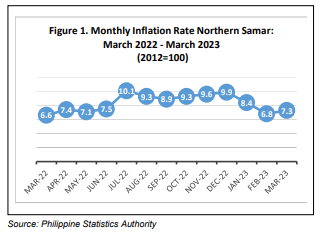
Three (3) out of seven (7) provinces, including one (1) HUC, in Eastern Visayas posted higher IR compared with their figures a month ago, while the four (4) provinces have a lower IR. The Regional IR registered a decrease of 0.4 percentage points from 6.3 percent in February to 5.9 percent in March 2023.
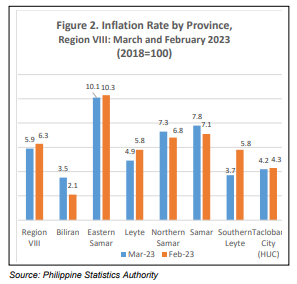
Biliran recorded the biggest increase among the provinces with an increase in inflation rate of 1.4 percentage points from a 2.1 IR in February to 3.5 IR for March 2023.
Samar and Northern Samar also posted an increase in inflation rate of 0.7 and 0.5 percentage points from a 7.1 and 6.8 in February to a 7.8 and 7.3 IR for the current month, respectively.
Southern Leyte posted a large decrease of 2.1 percentage points with 3.7 IR for March 2023 from a 5.8 IR in February. While Leyte has a minimal decrease of 0.9 percentage points with current IR of 4.9 from a 5.8 last months’ IR.
Eastern Samar recorded a 0.2 percentage point decrease from 10.3 IR in February to 10.1 IR for the month of March 2023.
For Tacloban City, a 0.1 percentage point decrease was observed for the month of March 2023 with 4.2 IR from a 4.3 IR in February.
BY COMMODITY
Out of thirteen (13) commodity groups in the province, two (2) commodity groups registered higher IRs while nine (9) commodity group registered a lower IR during the month in comparison with their rates a month ago. Whereas two (2) commodity groups retained its IR. The IRs resulted to a 0.5 percentage point increase in the overall IR of the province for the month of March 2023.
The increase in the province inflation was mainly brought about by a higher annual increment in the Food and Non-Alcoholic Beverages division which has a 64.9 percent contribution to inflation by division and a 91.3 percent share to inflation trend, with its current inflation rate of 9.4 from a 6.5 last months’ IR.
This can be traced due to the significant increases in the following:
a. Cereals, 8.2 percent;
b. Cane and beet sugar, 81.6 percent;
c. Other vegetables, fresh or chilled, 51.9 percent;
d. Fish, live, fresh, chilled or frozen, 9.7 percent;
e. Meat, fresh, chilled or frozen, 7.3 percent;
f. Eggs, 26.9 percent;
g. Bread and bakery products, 10.1 percent, and
h. Fruit-bearing vegetables, fresh or chilled, 20.5 percent.
It can be observed that the commodity group of Cereals; Fish, live, fresh, chilled or frozen and Fruit-bearing vegetables, fresh or chilled has a 54.9, 10.6 and 10.0 percent share to uptrend, respectively.
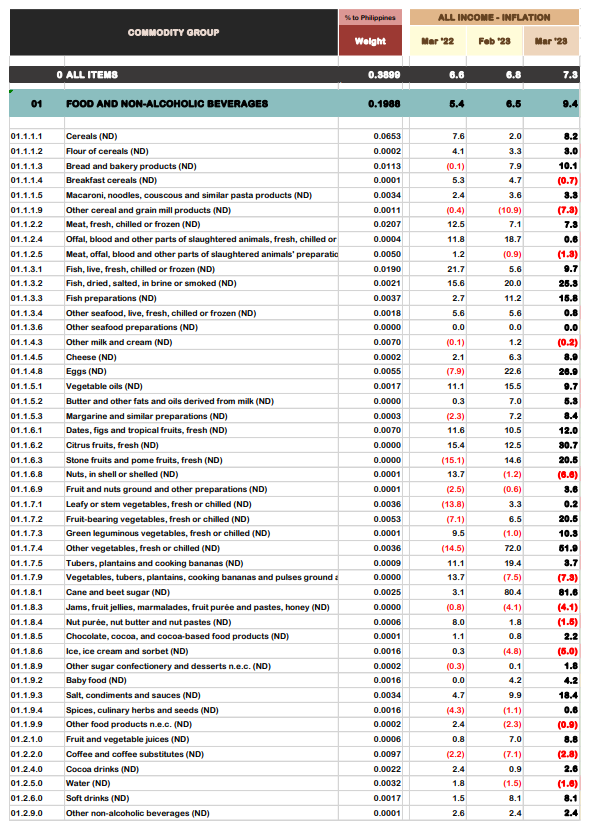
Alcoholic Beverages and Tobacco commodity group registered an increase in IR from 5.3 percent in February to 11.0 percent in March 2023, that is, a 5.7 percentage point increase. This division has a 3.7 percent contribution to inflation by division and 8.7 percent share to inflation trend.
This can be traced in the increase in Alcoholic Beverages registering a 3.3 percentage point increase from 6.4 to 9.7 IR for the current month, and Tobacco with a 10.1 percentage point increase from 3.5 to 13.5 IR.
Meanwhile, a decrease in the f o l l o w i n g divisions can also be observed:
a. Clothing and Footwear, (0.2) percent;
b. Housing, Water, Electricity, Gas and Other Fuels, 12.4 percent;
c. Furnishing Household equipment and routine maintenance of the house, 2.2 percent;
d. Health, (2.2) percent;
e. Transport, (5.9) percent;
f. Information & Communication, 3.2 percent;
g. Recreation, Sport and Culture, 2.7 percent;
h. Restaurant and Accommodation Services, 4.4 percent; and |
i. Personal Care, and Miscellaneous Goods and Services, 1.1 percent.
Education and Financial Services commodity groups retained their previous month’s inflation rates.
PURCHASING POWER OF PESO
The Purchasing Power of Peso (PPP) in the province decreases at P0.82 for March 2023. This PPP indicates that P100.00 in 2018 is only worth P82.00 in March 2023.
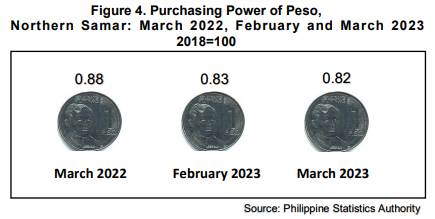
The PPP of the same month a year ago was P 0.06 higher at P 0.88 than this months’ PPP of P0.82.
Northern Samar PPP is the same with the Regional PPP at P 0.83, and registered third as one of the weakest PPP among the provinces in Eastern Visayas.
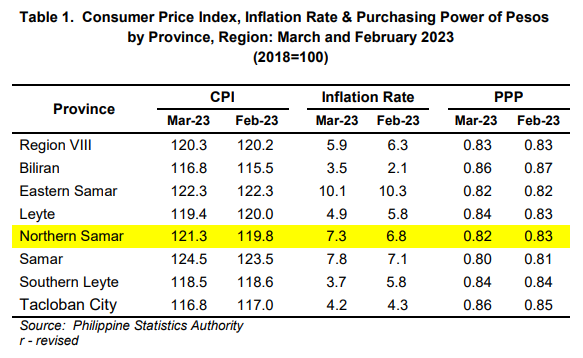
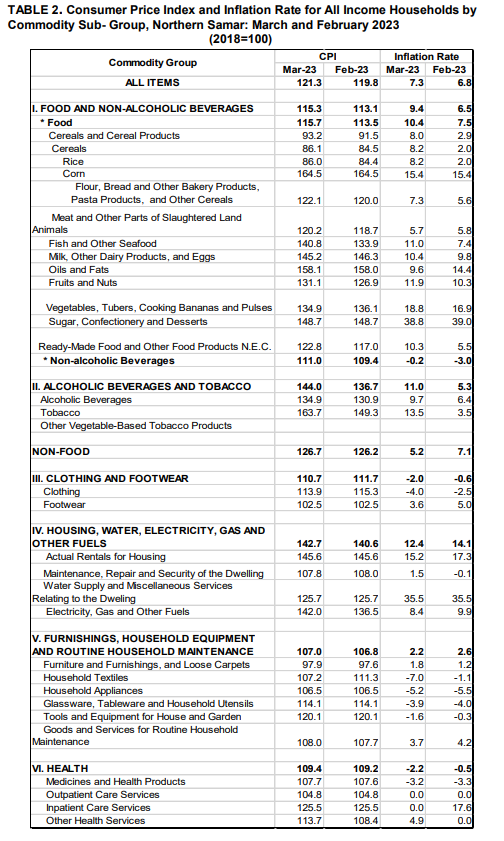
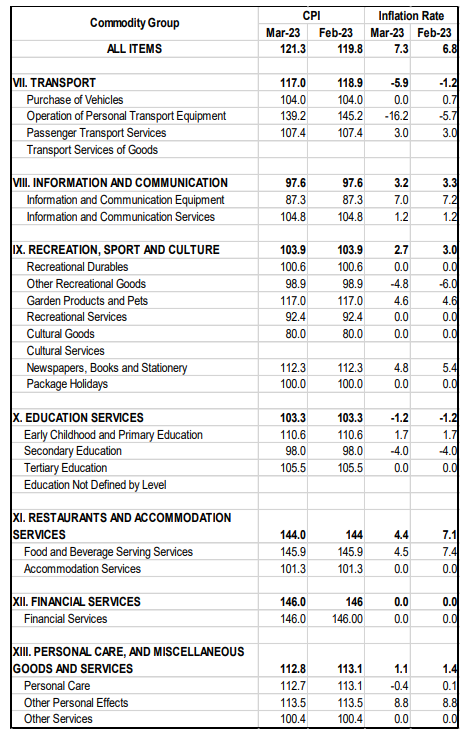
TECHNICAL NOTES
Rebasing of the CPI is necessary to ensure that this barometer of economic phenomena is truly reflective of current situation. Consumer taste, fashion and technology change over time causing the fixed market basket of goods and services to become outmoded. To capture such changes for a more meaningful price comparison, revision or updating of the fixed market basket, the sample outlets, the weights and the base year had to be done periodically.
CONSUMER PRICE INDEX – is an indicator of the changes in the average retail price of a fixed market basket of goods and services commonly purchased by households relative to a base year.
USES OF CPI - it is most widely used in the calculation of the inflation rate and purchasing power of peso. It is a major statistical series used for economic analysis and as a monitoring indicator of government economic policy.
COMPUTATION OF CPI - the computation of the CPI involves consideration of the following important points:
A. BASE PERIOD – refers to the reference period of the index number. It is a period at which the index is set to 100. Current base period is 2018.
B. MARKET BASKET - refers to a sample of goods and services used to represent all goods and services bought by a particular group of consumers in a particular area.
C. WEIGHTING SYSTEM- uses the expenditures on various consumer items purchased by households as a proportion to total expenditures.
D. FORMULA - the formula used in computing the CPI is the weighted arithmetic mean of price relatives, the Laspeyre’s formula with a fixed base year period (2018) weights.
E. GEOGRAPHIC COVERAGE - CPI values are computed at the national, regional, and provincial levels, and for selected cities.
RETAIL PRICE - refers to the actual price at which retailers sell a commodity on spot or earliest delivery, usually in small quantities for consumption and not for resale. It is confined to transactions on cash basis in the free market and excludes black-market prices and prices of commodities that are on sale as in summer sales, anniversary sales, Christmas sales, etc.
INFLATION RATE – refers to the rate of change of the CPI expressed in percent. Inflation is interpreted in terms of declining purchasing power of peso.
PURCHASING POWER PESO – it is a measure of how much the peso in the base period is worth in another period. It gives as indication of the real value in a given period relative to the peso value in the base period.
SGD. JULIAN E. GALLANO
Chief Statistical Specialist

